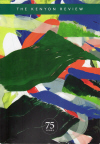The Kenyon Review – Winter 2014
Every issue of The Kenyon Review offers reason to celebrate, but this issue is particularly special, as it commemorates the journal’s seventy-fifth anniversary. Even better, the editors are taking a look back as they continue to publish cutting-edge work. The Kenyon Review’s first editor, John Crowe Ransom, published philosophical and aspirational statements composed by prominent intellectuals of the day. The tradition will continue in the coming year; sixteen writers who published in The Kenyon Review early in their careers will offer their own “contemporary credos.”
Every issue of The Kenyon Review offers reason to celebrate, but this issue is particularly special, as it commemorates the journal’s seventy-fifth anniversary. Even better, the editors are taking a look back as they continue to publish cutting-edge work. The Kenyon Review’s first editor, John Crowe Ransom, published philosophical and aspirational statements composed by prominent intellectuals of the day. The tradition will continue in the coming year; sixteen writers who published in The Kenyon Review early in their careers will offer their own “contemporary credos.”
Carl Phillips kicks things off, making a case for poetry that leaves the reader “bewildered” and “not quite certain of how to see the world again.” Phillips urges writers and readers to prize “transgressive” works and poetry that flows inevitably from the writer’s pen, avoiding “self-conscious” and “systemic” composition.
It should surprise no one that the Joyce Carol Oates short story in this issue is a standout. “The Home at Craigmillnar” stars Francis, an orderly in a nursing home. Francis, we quickly learn, had the misfortune of discovering the lifeless body of Sister Mary Alphonsus, an elderly nun who spent decades in charge of the Craigmillnar Home for Children. Sister Mary Alphonsus was not a very pleasant woman, but this is appropriate: Craigmillnar was not a pleasant place. The story is a slow burn that sheds light on a number of important questions. What, for example, is the value of a human life? Which God has the correct view regarding revenge: that of the Old Testament or the New?
Timothy Liu’s two poems, “The Gift” and “Sine Qua Non,” are delightful for their visceral lyricism. Both are first-person poems whose narrators address talented men: a sculptor and a violist. Both poems employ powerful imagery. In “Sine Qua Non,” the narrator looks over a former acquaintance and/or lover:
the way one looks at a German viola
made in 1768, once snubbed for not
being Italian, now safely displayed
behind glass . . .
What do you get when you choose three brief stories out of a field of 1,876? The winner and runners-up of the 2013 Kenyon Review Short Fiction Contest, of course. Entries were limited to writers who have not yet published a book of fiction. Katharine Weber and the other readers bestowed the award upon Heather Monley for her “Town of Birds,” an interesting little fable about “the town where the children turned into birds.” Monley delves into the heads and hearts of those who are left behind.
Willard Spiegelman contributes a long and engrossing essay about Mark Strand and the poet’s “luminous nostalgia.” Spiegelman fulfills all of the requirements of great literary analysis. His thoughts about Strand and his work are complicated but remain within the grasp of the layperson. Instead of a dry recitation of the Pulitzer Prize winner’s work, the reader is offered relevant personal anecdotes and representative snapshots of his poetry. The essay is a wonderful entry point for those who are unfamiliar with Strand’s work and who would like to address that oversight.
Above all, this issue is accompanied by an important implied promise. After seventy-five years of near-continuous publication, we’re excited by the prospect of seventy-five more.
[www.kenyonreview.org]





